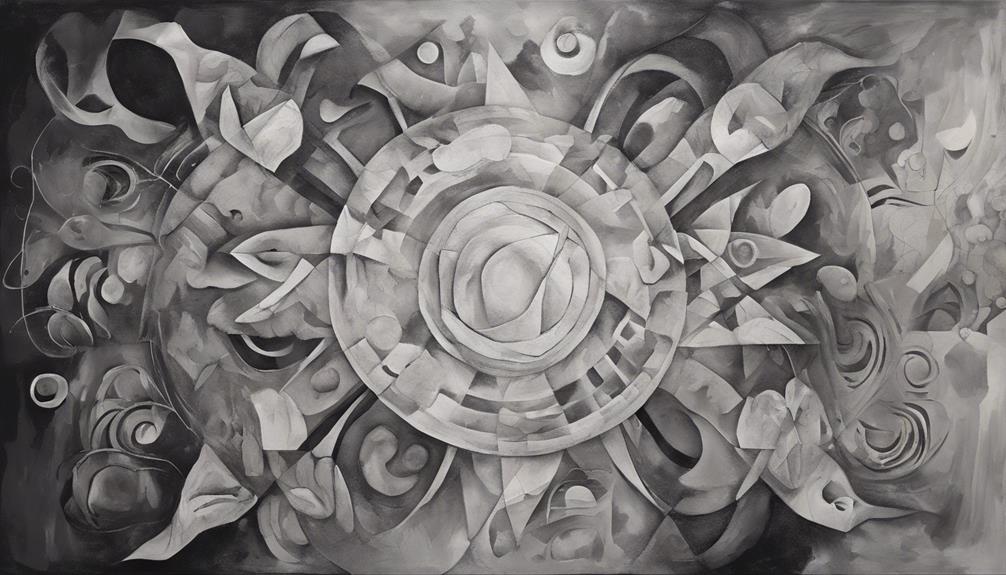Subliminal art, emerging in the early 20th century, incorporates hidden messages to engage viewers subconsciously. Artists like Salvador Dali and Rene Magritte strategically embed symbols and visual illusions into their works, guiding the viewer's perception. This form of art influences emotions and memories, shaping interpretations without explicit awareness. Ethical debates surround subliminal art's impact on consumer behavior and its blurred boundaries between art and commerce. Famous examples, such as Dali's 'The Sacrament of the Last Supper' and Pink Floyd's 'The Wall' album cover, showcase hidden symbolism that adds depth to the artwork.
Origins of Subliminal Art

The origins of subliminal art can be traced back to the early 20th century when artists began exploring the concept of embedding hidden messages and images within their works. This historical development marked a shift in artistic expression, as creators sought to engage viewers on a subconscious level through subtle visual cues.
The use of hidden messages in art has a rich history, with artists such as Salvador Dali and Rene Magritte known for incorporating symbolic elements that invited viewers to explore further into the meaning behind their compositions.
Techniques Used in Subliminal Art
Artists employ a variety of techniques to embed subliminal messages within their works, subtly influencing the viewer's perception and interpretation. One common method is through the use of hidden images, where subtle elements are strategically placed within the artwork to convey a secondary meaning. These hidden images can range from symbols and shapes to faces and words, adding layers of complexity to the piece.
Visual illusions are another powerful tool used in subliminal art, creating optical effects that deceive the viewer's eye and tap into the subconscious mind. By manipulating perspective, light, and color, artists can guide the viewer's gaze and evoke specific emotions or thoughts without their conscious awareness.
The subtle incorporation of subliminal messaging and visual illusions in artworks can have a profound impact on the viewer, shaping their interpretation of the piece and leaving a lasting impression on their subconscious.
Psychological Impact of Subliminal Art

By tapping into the subconscious mind through hidden imagery and visual illusions, subliminal art has the capacity to evoke profound psychological responses in viewers. Through subconscious messaging, subliminal art can influence visual perception, triggering emotions, memories, and associations that may not be consciously recognized.
Artists strategically employ artistic manipulation to convey hidden messages or suggestions that can impact consumer behavior without the viewer's explicit awareness.
The visual elements integrated into subliminal art possess the power to bypass conscious scrutiny and directly engage with the viewer's subconscious. This engagement can lead to altered perceptions, attitudes, and decision-making processes. By subtly implanting ideas or desires into the subconscious, subliminal art can shape individuals' responses and behaviors without their explicit knowledge.
Understanding the psychological impact of subliminal art is essential in comprehending how it can sway consumer behavior, influence perceptions, and evoke emotional responses. The interplay between hidden messages and visual presentation in subliminal art underscores its potential to provoke deep-seated psychological reactions in viewers.
Controversies Surrounding Subliminal Art
Controversies surrounding subliminal art often stem from concerns about its potential to manipulate perceptions and influence behavior without explicit consent. Ethical concerns arise regarding the use of subliminal messaging in art, especially in marketing contexts, where manipulation of consumer behavior is a primary goal. Critics argue that subliminal art can be a form of marketing manipulation, where hidden messages or symbols are strategically placed to subconsciously influence individuals' decisions, leading to purchases they might not have otherwise made.
The ethical debate surrounding subliminal art revolves around issues of transparency and consent. When individuals are unaware of the subconscious cues they are exposed to, questions of autonomy and free will come into play. Should artists and marketers be allowed to use subliminal techniques to sway opinions or actions without individuals' explicit knowledge or agreement?
As the boundaries between art and commerce blur, the discussion on the ethical implications of subliminal art becomes increasingly relevant in understanding how visual stimuli can impact human behavior and decision-making processes.
Famous Examples of Subliminal Art

The world of subliminal art is rich with examples that have captivated audiences and sparked discussions on the power of hidden messages in visual mediums.
One famous example is Salvador Dali's 'The Sacrament of the Last Supper,' where upon closer inspection, the face of Jesus reveals itself as a skull, symbolizing mortality. This visual illusion adds depth to the painting, inviting viewers to contemplate the dual nature of life and death.
Another renowned instance is the cover of Pink Floyd's album 'The Wall,' designed by Gerald Scarfe. The intricate artwork features hidden messages and symbols that reflect the album's themes of alienation and personal struggles. These subtle cues enhance the listener's experience, creating a deeper connection to the music.
Conclusion
To wrap up, subliminal art has a long history and utilizes various techniques to convey hidden messages to viewers. The psychological impact of subliminal art remains a topic of debate, with some arguing its potential influence on behavior and others questioning its effectiveness.
Despite controversies surrounding subliminal art, it continues to be a popular and intriguing aspect of the art world. One interesting statistic worth noting is that a study found that 60% of participants were influenced by subliminal messages in art.
Dr. John Renoldson is a distinguished professor of Clinical Research Hypnotherapy He holds a PhD in Clinical Psychology and specializes in hypnotherapy and scientific research to enhance therapeutic outcomes. Dr. Renoldson has authored numerous peer-reviewed articles on the efficacy of hypnosis in treating conditions.




